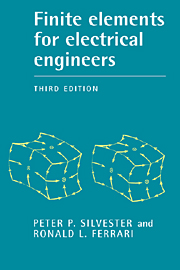Book contents
- Frontmatter
- Contents
- Preface to the third edition
- Preface to the first edition
- 1 Finite elements in one dimension
- 2 First-order triangular elements for potential problems
- 3 Electromagnetics of finite elements
- 4 Simplex elements for the scalar Helmholtz equation
- 5 Differential operators in ferromagnetic materials
- 6 Finite elements for integral operators
- 7 Curvilinear, vectorial and unbounded elements
- 8 Time and frequency domain problems in bounded systems
- 9 Unbounded radiation and scattering
- 10 Numerical solution of finite element equations
- Appendix 1 Calculations on simplex elements
- Appendix 2 Integration by parts, Green's theorems and Green's functions
- Appendix 3 Simplex element tables
- Appendix 4 Utility programs and style notes
- Appendix 5 Laboratory problems and exercises
- Index
5 - Differential operators in ferromagnetic materials
Published online by Cambridge University Press: 05 June 2012
- Frontmatter
- Contents
- Preface to the third edition
- Preface to the first edition
- 1 Finite elements in one dimension
- 2 First-order triangular elements for potential problems
- 3 Electromagnetics of finite elements
- 4 Simplex elements for the scalar Helmholtz equation
- 5 Differential operators in ferromagnetic materials
- 6 Finite elements for integral operators
- 7 Curvilinear, vectorial and unbounded elements
- 8 Time and frequency domain problems in bounded systems
- 9 Unbounded radiation and scattering
- 10 Numerical solution of finite element equations
- Appendix 1 Calculations on simplex elements
- Appendix 2 Integration by parts, Green's theorems and Green's functions
- Appendix 3 Simplex element tables
- Appendix 4 Utility programs and style notes
- Appendix 5 Laboratory problems and exercises
- Index
Summary
Introduction
Many of the problems of classical electrophysics that interest electrical engineers are inherently nonlinear. In fact it may be said that nonlinearity is an essential ingredient in almost all practical device analysis; nonlinearities determine the values over which field variables may range, and thereby fix the limits of device performance. Many useful devices could not function at all were they linear; mixers, modulators, and microwave circulators spring to mind as examples, but others can be found easily at any power level or in any part of the frequency spectrum.
Nonlinear finite element methods found early use in the analysis of power-frequency magnetic devices, most of which were not easily amenable to any other analytic technique, and a large part of the finite element literature in electrical engineering still deals with nonlinear magnetics. The nonlinearities encountered in such problems can often be assumed single-valued and monotonic so that comparatively simple methods can be made computationally efficient and reliable. For this reason, the present chapter will outline the major nonlinear methods used in magnetic field analysis. Other areas, such as problems of plasma electrochemistry or semiconductor devices, are generally amenable to similar mathematical techniques, though the electromagnetic formulations are often much more complicated.
Functional minimization for magnetic fields
The basic principles of linear finite element analysis carry over to nonlinear problems almost without modification. As always, a stationary functional is constructed and discretized over finite elements.
Information
- Type
- Chapter
- Information
- Finite Elements for Electrical Engineers , pp. 183 - 221Publisher: Cambridge University PressPrint publication year: 1996
